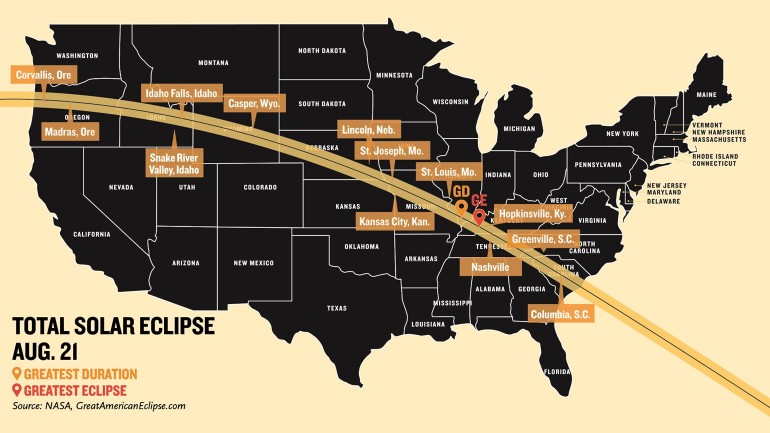Sponsored Listings:
A little more than two months before the total solar eclipse that will pass over the U.S. on Aug. 21, destinations located along what is known as the “path of totality” — a 70-mile-wide route that arches from South Carolina to Oregon — are preparing for a robust migration of eclipse watchers coming to view a site many will get to see only once in their lifetimes.
The town of Hopkinsville, Ky., which has been reported to be one of the best places to view the eclipse, has a population of around 32,000 and is expecting at least 50,000 visitors to descend there to view the phenomenon.
“Astronomers have [estimated] that it could be even more than that,” said Brooke Jung, the solar eclipse marketing and events consultant for Hopkinsville. “Since the last eclipse traversed the country in this nature 99 years ago, it is hard to approximate exact numbers, but we do know it will be larger than life. With 81% of the U.S. population within 600 miles of the path of totality, this will easily be the most viewed solar eclipse in history.”
The town is planning some two dozen events during what it is calling eclipse weekend in the lead-up to the main event, the total eclipse, which will take place on Aug. 21.
According to the American Astronomical Society, the only total solar eclipses that have occurred in the last 40 years in the U.S. were in 1979, in the northwest part of the country, and 1991 in Hawaii.
All other eclipses during that time in the U.S. were either partial eclipses, or annular eclipses, during which the moon does not completely cover the sun.
For a total solar eclipse, the moon moves directly into the path of the sun, covering it completely for a period of one or two minutes, allowing viewers with protective solar viewing glasses to look right at the sun and witness daytime turn briefly into night.
A total solar eclipse can occur once a year or every other year, but often they are best seen from much more remote corners of the planet. This year, however, since it will be much closer to home for many Americans, it is driving strong interest.
“Every eclipse is different,” said Paul Maley, an astronomer who formerly worked in the aerospace industry at the NASA Johnson Space Center. “But when the sun disappears, regardless for how long or where, anybody inside this path of the total eclipse is going to get a chance to really see an unusual event that they normally will never see in their lifetime.”
Maley hosts guided eclipse tours throughout the world through Ring of Fire Expeditions (which can be found at Eclipsetours.com). He has hosted 47 eclipse-viewing expeditions worldwide, and witnessed many more himself.
Normally, he will take a group of about 15 to 30 people to an eclipse destination, but for the upcoming American total eclipse, he will be hosting some 200 people for a viewing in Grand Island, Neb., a destination he believes will be easier to navigate than some of the eclipse hot spots.
Maley said that even for people who normally pay scant attention to astronomy, witnessing this event could be worth the effort.
“People who aren’t astronomers, who aren’t eclipse chasers, who just happen to be exposed to this one singular event, it’s either going to be potentially life changing or it will be just an oddity,” Maley said.
He added: “This year, because of the fact that this eclipse crosses the entire country and it doesn’t really cross any other land mass, there’s more of an intense interest internally within the U.S. to get information and stories out to expose people to what’s going to happen.”
Maley’s Nebraska tour is sold out, but he said his tour company is still selling space on Royal Caribbean’s Oasis of the Seas, which will be sailing through the path of totality as it runs through the Bahamas, the Dominican Republic and Puerto Rico prior to reaching South Carolina. The Aug. 20 sailing has been dubbed an “eclipse cruise” by Royal Caribbean.
And there are other options, too. Kentucky tourism officials advised travelers to call individual hotels to ask about availability during the eclipse. Maley said that people who find themselves within a few hundred miles of the eclipse path could just hop in their cars and drive.
Sоurсе: travelweekly.com










